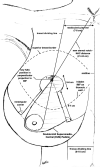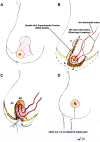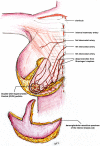Double-Unit Superomedio-Central (DUS) Pedicle Inverted-T Reduction Mammaplasty in Gigantomastia: A 7-year Single-Center Retrospective Study
- PMID: 34145475
- PMCID: PMC8481221
- DOI: 10.1007/s00266-021-02351-y
Double-Unit Superomedio-Central (DUS) Pedicle Inverted-T Reduction Mammaplasty in Gigantomastia: A 7-year Single-Center Retrospective Study
Abstract
Introduction: Reduction mammaplasty in patients with gigantomastia is challenging. The Double-Unit technique with a Superomedio-Central pedicle and inverted-T incision is the standard technique for reduction mammaplasty in our clinic. The aim of this study was to review our approach in cases with gigantomastia in comparison with the current literature.
Patients and methods: From 01/2011 to 12/2017, we performed 831 reduction mammaplasties in 630 patients. The Double-Unit Superomedio-Central (DUS) pedicle and inverted-T incision was implemented as a standard procedure for gigantomastia. Patient demographics and the outcome parameters complication rate, patient satisfaction with the aesthetic result, nipple sensibility, and surgical revision rate were obtained and retrospectively analyzed.
Results: In 37 patients, 55 reduction mammaplasties were performed with more than 1000 g per breast. Mean resection weight was 1311 g on right side and 1289 g on left side. Mean age was 52.5 years, mean body mass index was 32.8 kg/m2, mean sternal-notch-to-nipple distance was 38.3 cm. A free NAC graft was necessary in four breasts. Overall complication rate was 14.5%; secondary surgical revision rate was 12.7%. 91% of the patients were "very satisfied" and "satisfied" with the aesthetic result. Nipple sensibility was rated "high" and "medium" in 83%.
Conclusion: The Double-Unit technique with a Superomedio-Central pedicle and inverted-T incision is very effective to achieve volume reduction and aesthetically pleasing reproducible results with a low complication rate in cases with gigantomastia.
Level of evidence: Level of Evidence This journal requires that authors assign a level of evidence to each article. For a full description of these Evidence-Based Medicine ratings, please refer to the Table of Contents or the online Instructions to Authors www.springer.com/00266 .
Keywords: Breast reduction; Gigantomastia; Macromastia; Reduction mammaplasty; Severe mammahypertrophy; Superomedial pedicle.
© 2021. The Author(s).
Conflict of interest statement
The authors have no conflict of interest to disclose.
Figures











Comment in
-
Invited Discussion on: Double-Unit Superomedio-Central (DUS) Pedicle Inverted-T Reduction Mammaplasty in Gigantomastia-A 7-Year Single-Center Retrospective Study.Aesthetic Plast Surg. 2021 Oct;45(5):2075-2076. doi: 10.1007/s00266-021-02400-6. Epub 2021 Jun 28. Aesthetic Plast Surg. 2021. PMID: 34184093 No abstract available.
Similar articles
-
Superomedial Pedicle Technique and Management of Circulation Problems in Gigantomastia : Treatment of Gigantomastia.Aesthetic Plast Surg. 2024 Oct;48(19):1-11. doi: 10.1007/s00266-024-03913-6. Epub 2024 Mar 20. Aesthetic Plast Surg. 2024. PMID: 38509317 Free PMC article.
-
Septum-Enhanced Mammaplasty in Inferocentral Pedicled Breast Reduction for Macromastia and Gigantomastia Patients.Aesthetic Plast Surg. 2017 Oct;41(5):1037-1044. doi: 10.1007/s00266-017-0868-1. Epub 2017 Apr 3. Aesthetic Plast Surg. 2017. PMID: 28374304
-
[Ribeiro-Technique in Gigantomastia - Review of 294 Reduction Mammaplasties in 8 Years].Handchir Mikrochir Plast Chir. 2017 Dec;49(6):390-398. doi: 10.1055/s-0043-113132. Epub 2017 Aug 1. Handchir Mikrochir Plast Chir. 2017. PMID: 28763811 German.
-
How to Approach Secondary Breast Reduction: International Trends and a Systematic Review of the Literature.Aesthetic Plast Surg. 2021 Dec;45(6):2555-2567. doi: 10.1007/s00266-021-02243-1. Epub 2021 Apr 5. Aesthetic Plast Surg. 2021. PMID: 33821309 Free PMC article.
-
Aesthetic, Quality-of-Life, and Clinical Outcomes after Inferior Pedicle Oncoplastic Reduction Mammoplasty.Aesthetic Plast Surg. 2023 Jun;47(3):905-911. doi: 10.1007/s00266-023-03257-7. Epub 2023 Feb 3. Aesthetic Plast Surg. 2023. PMID: 36735002 Review.
Cited by
-
Risk factor stratification of three different pedicle techniques in reduction mammaplasty-the importance of an armamentarium of techniques individually addressing mild to severe breast hypertrophy.Gland Surg. 2022 Dec;11(12):1848-1850. doi: 10.21037/gs-22-541. Gland Surg. 2022. PMID: 36654952 Free PMC article. No abstract available.
-
Superomedial Pedicle Technique and Management of Circulation Problems in Gigantomastia : Treatment of Gigantomastia.Aesthetic Plast Surg. 2024 Oct;48(19):1-11. doi: 10.1007/s00266-024-03913-6. Epub 2024 Mar 20. Aesthetic Plast Surg. 2024. PMID: 38509317 Free PMC article.
-
Inverted-T pattern reduction mammoplasty in bilateral breast ptosis: cosmetic and oncological outcomes.Gland Surg. 2021 Oct;10(10):2925-2934. doi: 10.21037/gs-21-561. Gland Surg. 2021. PMID: 34804880 Free PMC article.
-
Medial Pedicle Wise-pattern Breast Reduction for Gigantomastia: A Single-center Retrospective Review.Plast Reconstr Surg Glob Open. 2023 Aug 4;11(8):e5170. doi: 10.1097/GOX.0000000000005170. eCollection 2023 Aug. Plast Reconstr Surg Glob Open. 2023. PMID: 37547348 Free PMC article.
References
MeSH terms
Supplementary concepts
LinkOut - more resources
Full Text Sources
Medical
Research Materials

